Abstract
Event-related brain potentials (ERPs) were recorded during spoken language comprehension to study the on-line effects of gender agreement violations in controlled infinitival complements. Spanish sentences were constructed in which the complement clause contained a predicate adjective marked for syntactic gender. By manipulating the gender of the antecedent (i.e., the controller) of the implicit subject while holding constant the gender of the adjective, pairs of grammatical and ungrammatical sentences were created. The detection of such a gender agreement violation would indicate that the parser had established the coreference relation between the null subject and its antecedent. The results showed a complex biphasic ERP (i.e., an early negativity with prominence at anterior and central sites, followed by a centroparietal positivity) in the violating condition as compared to the non-violating conditions. The brain reacts to NP-adjective gender agreement violations within a few hundred milliseconds of their occurrence. The data imply that the parser has properly coindexed the null subject of an infinitive clause with its antecedent.
Similar content being viewed by others
REFERENCES
Chomsky, N. (1981). Lectures on government and binding. Dordrecht: Foris.
Chomsky, N. (1986). Knowledge of language: Its nature, origin and use. New York: Praeger.
Clifton, C., & L. Frazier (1989). Long-distance dependencies. In G. Carlson and M. Tanenhaus (Eds.), Linguistic structure in language processing. Dordrecht: Kluwer Academic.
Coulson, S., King, J., & Kutas, M. (1998). Expect the unexpected: Event-related brain response to morphosyntactic violations. Language and Cognitive Processes, 13, 21-58.
Elías-Cintrón, R. (1995). Towards a general theory of agreement: A psycholinguistic study of Spanish gender. Doctoral dissertation, Cornell University, Ithaca, NY.
Fodor, J. D. (1989). Empty categories in sentence processing. Language and Cognitive Processes, 4, 155-209.
Ferreira, F., & Clifton, C., Jr. (1986). The independence of syntactic processing. Journal of Memory and Language, 25, 348-368.
Frazier, L. (1987). Sentence processing: A tutorial review. In M. Coltheart (Ed.), Attention and performance XII. Hillsdale, NJ: Erlbaum.
Frazier, L. (1990). Exploring the architecture of the language-processing system. In G. Altmann (Ed.), Cognitive models of speech processing: Psycholinguistic and computational perspectives. Cambridge, MA: MIT Press.
Frazier, L., & Rayner, K. (1982). Making and correcting errors during sentence comprehension: Eye movements in the analysis of structurally ambiguous sentences. Cognitive Psychology, 14, 178-210.
Frazier, L., Clifton, C., & Randall, J. (1983). Filling gaps: Decision principles and structure in sentence comprehension. Cognition, 13, 187-222.
Friederici, A. D., Pfeifer, E., & Hahne, A. (1993). Event-related brain potentials during natural speech processing: Effects of semantic, morphological, and syntactic violations. Cognitive Brain Research, 1, 183-192.
Friederici, A. D., Hahne, A., & Mecklinger, A. (1996). Temporal structure of syntactic parsing: Early and late event-related brain potential effects. Journal of Experimental Psychology: Learning, Memory and Cognition, 22(5), 1219-1248.
García-Albea, J. E., Demestre, J., & Meltzer, S (1997). Constricciones léxicosemánticas en la asignación del antecedente al sujeto nulo de cláusulas de infinitivo. Paper presented at the III Symposio de Psicolingüística, Oviedo, Spain, April.
Gamsey, S. M. (1993). Event-related potentials in the study of language: An introduction. Language and Cognitive Processes, 8, 337-356.
Gunter, T. C., Vos, S. H., & Mulder, G. (1995). Syntactic violations and ERPs: P600 or P3b? Paper presented at the Eighth Annual CUNY Conference on Human Sentence Processing, Tucson, Az.
Hagoort, P., Brown, C., & Groothusen, J. (1993). The syntactic positive shift as an ERP measure of syntactic processing. Language and Cognitive Processes, 8, 439-483.
Harris, J. W. (1991). The exponence of gender in Spanish. Linguistic Inquiry, 22(I), 27-62.
Hillyard, S. A., & Picton, T. W. (1987). Electrophysiology of cognition. In F. Plum (Ed.), Handbook of physiology: Higher functions of the nervous system: Section I: Neurophysiology. New York: American Physiological Society.
Holcomb, P. J., & Neville, H. J. (1991). Natural speech processing: An analysis using event-related brain potentials. Psychobiology, 19, 286-300.
Kluender, R., & Kutas, M. (1993). Subjacency as a processing phenomenon. Language and Cognitive Processes, 8, 573-633.
Kutas, M., & Hillyard, S. A. (1980a). Event-related brain potentials to semantically inappropriate and surprisingly large words. Biological Psychology, 11, 99-116.
Kutas, M., & Hillyard, S. A. (1980b). Reading between the lines: Event-related brain potentials during natural sentence processing. Brain and Language, 11, 354-373.
Kutas, M., & Hillyard, S. A. (1980c). Reading senseless sentences: Brain potentials reflect semantic anomaly. Science, 207, 203-205.
Kutas, M., & van Petten, C. (1988). Event-related potentials studies of language. In P. K. Ackles, J. R. Jennings, & M. G. H. Coles (Eds.), Advances in psychophysiology. Greenwich, CT: JAI Press.
Manzini, R. (1983). On control and control theory. Linguistic Inquiry, 14, 421-446.
MacDonald, M. C. (1994). Probabilistic constraints and syntactic ambiguity resolution. Language and Cognitive Processes, 9, 692-715.
MacDonald, M. C., Pearlmutter, N. J., & Seidenberg, M. S. (1994). The lexical nature of syntactic ambiguity resolution. Psychological Review, 101, 676-703.
McKinnon, R., & Osterhout, L. (1996). Constraints on movement phenomena in sentence processing: Evidence from event-related brain potentials. Language and Cognitive Processes, 11, 495-523.
Münte, T. F., Heinze, H., & Mangun, G. R. (1993). Dissociation of brain activity related to syntactic and semantic aspects of language. Journal of Cognitive Neuroscience, 5, 335-344
Neville, H. J., Nicol, J., Barss, A., Forster, K., & Garrett, M. (1991). Syntactically based sentence processing classes: Evidence from event-related brain potentials. Journal of Cognitive Neuroscience, 3, 151-165.
Nicol; J. (1988). Coreference processing during sentence comprehension. Unpublished doctoral dissertation, MIT, Cambridge, MA.
Nicol, J., & Swinney, D. (1989). The role of structure in coreference assignment during sentence comprehension. Journal of Psycholinguistic Research, 18(1), 5-19.
Nicol, J., Fodor, J. D., & Swinney, D. (1994). Using cross-modal lexical decision tasks to investigate sentence processing. Journal of Experimental Psychology: Learning, Memory and Cognition, 20, 1229-1238.
O'Brien, R. G., & Kaiser, M. K. (1985). MANOVA method for analyzing repeated measures designs: An extensive primer. Psychological Bulletin, 97, 316-333.
Osterhout, L. (1994). Event-related brain potentials as tools for comprehending language comprehension. In C. Clifton, L. Frazier, & K. Rayner (Eds.), Perspectives on sentence processing. Hillsdale, NJ: Erlbaum.
Osterhout, L. (1997). On the brain responses to syntactic anomalies: Manipulations of word position and word class reveal individual differences. Brain and Language, 59, 494-522.
Osterhout, L., & Holcomb, P. J. (1992). Event-related brain potentials elicited by syntactic anomaly. Journal of Memory and Language, 31, 785-806.
Osterhout, L., & Holcomb, P. J. (1993). Event-related potentials and syntactic anomaly: Evidence of anomaly detection during the perception of continuous speech. Language and Cognitive Processes, 8, 413-438.
Osterhout, L., & Holcomb, P. J. (1995). Event-related potentials and language comprehension. In M. G. H. Coles & M. D. Rugg (Eds.), Electrophysiology of mind: Event-related brain potentials and cognition. Oxford: Oxford University Press.
Osterhout, L., & Mobley, L. A. (1995). Event-related brain potentials elicited by failure to agree. Journal of Memory and Language, 34, 739-773.
Osterhout, L., Holcomb, P. J., & Swinney, D. A. (1994). Brain potentials elicited by gardenpath sentences: Evidence of the application of verb information during parsing. Journal of Experimental Psychology: Learning, Memory and Cognition, 20, 786-803.
Rayner, K., Carlson, M., & Frazier, L. (1983). The interaction of syntax and semantics during sentence processing: Eye movements in the analysis of semantically biased verbs. Journal of Verbal Learning and Verbal Behavior, 22, 358-374.
Rösler, F., Friederici, A. D., Pütz, P., & Hahne, A. (1993). Event-related brain potentials while encountering semantic and syntactic constraint violations. Journal of Cognitive Neuroscience, 5, 345-362.
Swinney, D. (1979). Lexical access during sentence comprehension: (re)consideration of context effect. Journal of Verbal Learning and Verbal Behavior, 18, 645-659.
Swinney, D., W. Onifer, P. Prather, and M. Hirshkowitz (1979). Semantic facilitation across sentence modalities in the processing of individual words and sentences. Memory and Cognition, 7, 159-165.
Swinney, D., Ford, M., Frauenfelder, U., & Bresnan, J. (1988). On the temporal course of gap filling and antecedent assignment during sentence comprehension. In B. Grosz, R. Kaplan, M. Macken, & I. Sag (Eds.), Language structure and processing. Stanford, CA: CSLI.
Tanenhaus, M. K., & Trueswell, J. C. (1995). Sentence Comprehension. In J. Miller, & P. Eimas (Eds.), Speech, language and communication. Handbook of perception and cognition. San Diego, CA: Academic Press.
Trueswell, J. C., & Tanenhaus, M. K. (1994). Toward a constraint-based lexicalist approach to syntactic ambiguity resolution. In C. Clifton, L.
Frazier, & K. Rayner (Eds.), Perspectives on sentence processing. Hillsdale, NJ: Erlbaum.
Vasey, M. W., & Thayer, J. F. (1987). The continuing problem of false positives in repeated measures ANOVA in psychophysiology: A multivariate solution. Psychophysiology, 24(4), 479-486.
Author information
Authors and Affiliations
Rights and permissions
About this article
Cite this article
Demestre, J., Meltzer, S., García-Albea, J.E. et al. Identifying the Null Subject: Evidence from Event-Related Brain Potentials. J Psycholinguist Res 28, 293–312 (1999). https://doi.org/10.1023/A:1023258215604
Issue Date:
DOI: https://doi.org/10.1023/A:1023258215604




